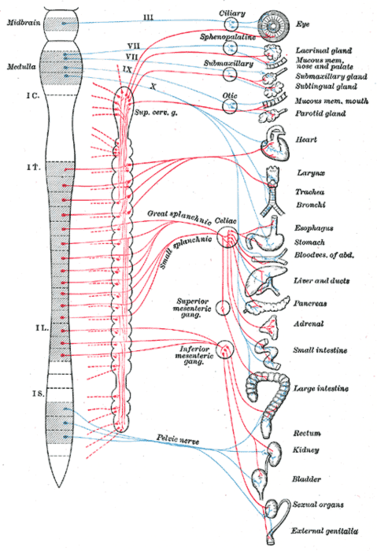Autonomic nervous system
The autonomous nervous system (ANS), vegetative nervous system or visceral nervous system is the part of the peripheral nervous system that controls the involuntary functions of the viscera, such as heart rate, digestion, respiratory rate, salivation, sweating, pupil dilation, urination. It is classically subdivided into two subsystems: the sympathetic nervous system and the parasympathetic nervous system. The autonomic nervous system plays a fundamental role in maintaining physiological homeostasis.
The autonomic nervous system is, above all, an efferent system, that is, it transmits nerve impulses from the central nervous system to the periphery, stimulating the peripheral organ systems and apparatus. Most of the actions it controls are involuntary, although some, such as breathing, act in conjunction with conscious actions. The malfunction of this system can cause various symptoms, which are grouped under the generic name of dysautonomia. The autonomic or autonomic nervous system, unlike the somatic and central nervous system, is involuntary and responds mainly to nerve impulses in the spinal cord, brain stem, and hypothalamus. Also, some portions of the cerebral cortex, such as the limbic cortex, can transmit impulses to lower centers and thus influence autonomic control.
Autonomic nerves are made up of all efferent fibers leaving the central nervous system, except those that innervate skeletal muscle. There are afferent autonomic fibers, which transmit information from the periphery to the central nervous system, taking charge of transmitting visceral sensation and the regulation of vasomotor and respiratory reflexes, for example, the baroreceptors and chemoreceptors of the carotid sinus and aortic arch, which are very important in the control heart rate, blood pressure and respiratory movements. These afferent fibers are carried to the central nervous system by major autonomic nerves such as the pneumogastric, splanchnic, or pelvic nerves.
The autonomic nervous system also works through visceral reflexes, that is, sensory signals entering the autonomic ganglia, spinal cord, brain stem, or hypothalamus can cause appropriate reflex responses that are returned to the organs for control their activity. Simple reflexes terminate in the corresponding organs, while more complex reflexes are controlled by higher autonomic centers in the central nervous system, primarily the hypothalamus.
Structure
The autonomic or vegetative nervous system is functionally divided into 3 parts:
- Sympathetic system
- From toracolumbar disposition and with its nodes away from the effector organ. Use noradrenaline and adrenaline as a neurotransmitter, and make it a chain paravertebral nodes located on both sides of the spine forming the so-called sympathetic trunkas well as some or preaortic lymph nodes, attached to the previous face of the aorta (celiac goglios, aortic-renals, upper mesenteric and lower mesenteric). It is involved in activities that require energy spending. It is also called an adrenergic or noradrenergic system; it is the one that prepares the body to react to a stress situation.
- Parasitic system
- From a skull-sacra disposition, it is formed by the isolated nodes, since these are close to the effecting organ. Use acetylcholine. It is in charge of storing and conserving the energy. It is also called a colinnergic system; it is the one that keeps the body in normal situations and after the stress situation has passed. It's antagonistic to the sympathetic.
- Enteric nervous system
- The gastrointestinal system is directly controlled. The SNE consists of one hundred million neurons, (a thousandth of the number of neurons in the brain, and much more than the number of neurons in the spinal cord) which have the gastrointestinal system.
Contenido relacionado
Poliomyelitis
Nuclear magnetic resonance
Trigynaea

